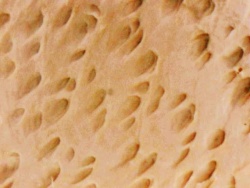Difference between revisions of "Crust leather"
| Line 37: | Line 37: | ||
==Crusting== | ==Crusting== | ||
| − | Crusting is part of the [[Leather production|tannery working steps for leather produciton]]. Crusting is when the hide is [[Leather production#Shaving|thinned]], [[tanning leather#retanned|retanned]] and [[tanning leather#Dyeing (through colouring) and fatliquoring|regreased]]. Often a coloring operation is included in the crusting process. Also part of the crusting process is the [[Drying leather|drying]] and [[softening]]. | + | Crusting is part of the [[Leather production|tannery working steps for leather produciton]]. Crusting is when the hide is [[Leather production#Shaving|thinned]], [[tanning leather#retanned|retanned]] and [[tanning leather#Dyeing (through colouring) and [[fatliquoring|regreased]]. Often a coloring operation is included in the crusting process. Also part of the crusting process is the [[Drying leather|drying]] and [[softening]]. |
| − | + | Crusting may include depending on the [[types of leather|type of leather]] the following working steps: | |
| − | + | * '''[[Split leather|Splitting]]''': The leather is split into one or more horizontal layers. | |
| − | + | * '''[[Neutralising|neutralisation]]''': The pH of the leather is adjusted. | |
| − | + | * '''[[[[tanning leather#retanned||Retanning]]''': Additional tanning imparts properties. | |
| − | + | * '''[[Leather dye - Leather color - Leather colour#Dyed leather|Dyeing]]''': The leather is coloured in the drum. | |
| − | + | * '''[[Fatliquoring]]''': Fats and oils and waxes soften the leather fibres. | |
| − | + | * '''[[Shaving]]''': The leather is thinned using a machine which cuts leather fibres off the [[flesh side]]. | |
| − | + | * '''Wetting''': Leather has to be rehydrated depending on the following working steps. | |
| − | neutralisation | + | * '''[[Drying leather|Sammying]]''': Water is squeezed out the leather. |
| − | + | ||
| − | + | ||
| − | + | ||
| − | + | ||
| − | + | ||
| − | + | ||
filling - heavy/dense chemicals that make the leather harder and heavier are added. | filling - heavy/dense chemicals that make the leather harder and heavier are added. | ||
| − | |||
stuffing - fats/oils and waxes are added between the fibres. | stuffing - fats/oils and waxes are added between the fibres. | ||
Revision as of 21:44, 14 November 2016
Crust leather
Crustleder ist Leder, das nach der Gerbung getrocknet, aber noch nicht gefärbt ist. Bei chromgegerbten Ledern spricht man dann von "Chrom-Crust" oder bei pflanzlich gegerbten Ledern von "Pflanzen-Crust". Ein weiterer Begriff für "Crustleder" ist "Borke" oder "Borkeleder".
Crustleder wird nur selten weiterverarbeitet. Meist werden die Leder vor der Verarbeitung noch gefärbt und zugerichtet.
"Pflanzencrust" - "Chromcrust"
Pflanzliche Crustleder verarbeitet.
Unusual. Chrom-Crust weiterverarbeitet. Die Färbung ist so nicht ansprechend. Daher eher eine "Billig-Lösung".
Crusting
Crusting is part of the tannery working steps for leather produciton. Crusting is when the hide is thinned, retanned and [[tanning leather#Dyeing (through colouring) and regreased. Often a coloring operation is included in the crusting process. Also part of the crusting process is the drying and softening.
Crusting may include depending on the type of leather the following working steps:
- Splitting: The leather is split into one or more horizontal layers.
- neutralisation: The pH of the leather is adjusted.
- [[|Retanning: Additional tanning imparts properties.
- Dyeing: The leather is coloured in the drum.
- Fatliquoring: Fats and oils and waxes soften the leather fibres.
- Shaving: The leather is thinned using a machine which cuts leather fibres off the flesh side.
- Wetting: Leather has to be rehydrated depending on the following working steps.
- Sammying: Water is squeezed out the leather.
filling - heavy/dense chemicals that make the leather harder and heavier are added. stuffing - fats/oils and waxes are added between the fibres.
stripping - superficially fixed tannins are removed.
whitening - the colour of the leather is lightened.
fixation - all unbound chemicals are chemically bonded/trapped or removed from the leather
setting - area, grain flatness are imparted and excess water removed.
drying - the leather is dried to various moisture levels (commonly 14-25%).
conditioning - water is added to the leather to a level of 18-28%.
softening - physical softening of the leather by separating the leather fibres.
buffing - abrasion of the surfaces of the leather to reduce nap or grain defects.
Additional information













 a kotori web solution
a kotori web solution